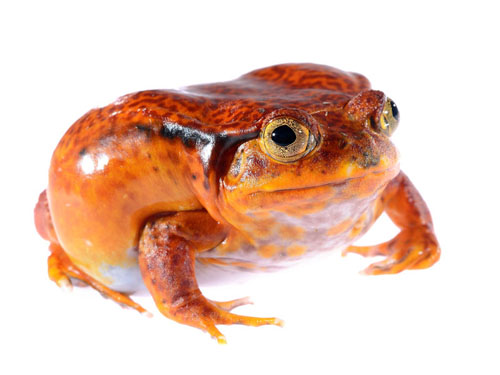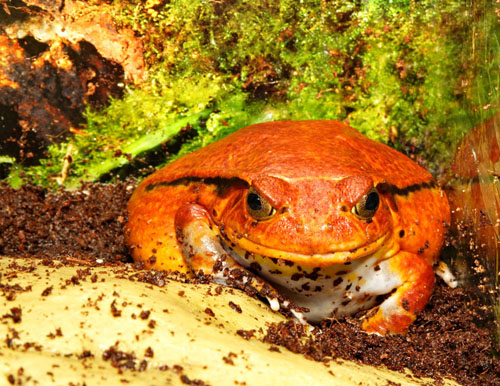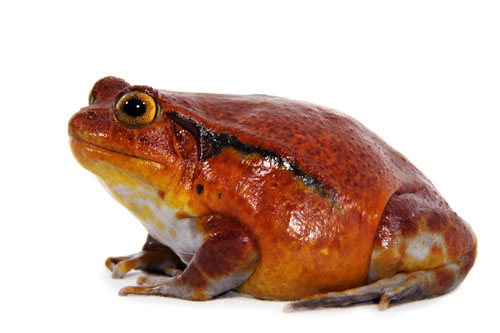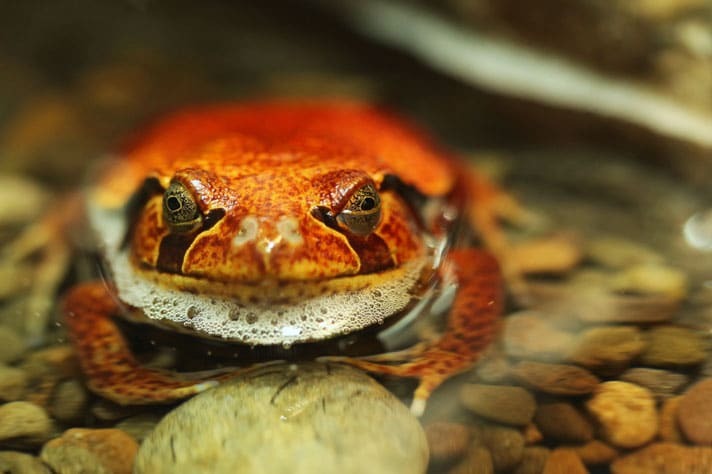Expert Care for the Tomato Frog (Dyscophus guineti).
Tomato Frog (Dyscophus guineti)
The tomato frog makes a hardy pet provided the frog supplies and basic care needs, provided here, are met. It is the largest member of the Microhylid group of frogs. Its native habitat is on the island of Madagascar off the east coast of Africa, where it inhabits forests and fields that receive heavy rainfall during the late spring and summer. Adult female tomato frogs exhibit an attractive, bright red-orange color, the origin of the frog’s common name.
Tomato Frog Availability
Tomato frogs are usually available throughout the year, but particularly during late spring and early summer in the U.S. Both captive-bred and wild-caught tomato frogs show up in the pet trade; I recommend starting out with a young captive-bred tomato frog, because captive-bred frogs are much more likely to be free of parasites and disease, both of which are a larger risk in wild-caught frogs. Young tomato frogs display a yellowish brown color on top, and a pale gray-brown color on the sides. If you can’t find captive-bred juveniles in a local pet store, they are commonly available at reptile shows and from online vendors.

Photo credit: Aleksey Stemmer/Shutterstock
Look no further than this photo to know how a tomato frog comes by its common name.
Tomato Frog Size
Adult males can reach 2.5 inches, while females can grow as large as 4 inches from snout to vent. Youngsters are generally 1 to 1.5 inches when sold. They grow quickly and can reach adult size within a year if fed well. Two years is the minimum time frame required for a female to mature.
Tomato Frog Life Span
Although pet tomato frogs may live as long as 10 years, six years is the average.
Tomato Frog Housing
A 10-gallon aquarium can house two adult tomato frogs, but a larger terrarium is advisable to allow the frogs room to explore and distance themselves from each other if desired. Half-branch log tunnels, such as the Zoo Med Habba Hut, will provide a good hiding spot. Plants such as Pothos (devil’s ivy) can be included, but tomato frogs burrow, which may disturb plants and hamper their growth. Plastic plants such as the Exo Terra Mandarin Plastic Silk Plant and Fluker’s Pothos Repta-Vines are a good alternative. Overall, the Tomato Frog benefits from a variety of amphibian accessories in the habitat. A shallow water dish like the Flukers Corner Reptile Bowl, containing dechlorinated water should be provided, using products such as the Zoo Med Reptisafe Reptile Water Conditioner.

Photo credit: Lana Langlois/Shutterstock
Because they like to burrow, tomato frogs appreciate a substrate that will allow them to do so, such as soil or coconut fiber.
Tomato Frog Lighting and Temperature
Lighting is not essential for tomato frogs, but if you wish to grow live plants in your tomato frog terrarium, you will need a daylight spectrum bulb, such as the fluorescent tubes sold for freshwater aquariums, and an appropriate lighting fixture. Tomato frogs do not require UV lighting.
Tomato frogs do well at temperatures between 65 and 80 degrees Fahrenheit. If the ambient temperature in your home falls below 65 degrees during the winter, a thermostatically controlled heat pad. such as the Zoo Med ReptiTherm Under Tank Heater, should be used beneath a section of your tomato frog terrarium. Keep track of temperatures with thermostats such as the Zoo Med Reptitemp Infrared Thermometer, as those much higher than 80 degrees can result in the death of your tomato frogs.
Humidity should be maintained by misting every one to three days with a mister such as the Exo Terra Mister Portable Pressure Sprayer and monitored with a humidity hygrometer. A glass lid with some ventilation will help keep humidity up; just be sure there is sufficient ventilation to prevent respiratory disorders from occurring in the tomato frogs.
Tomato Frog Substrate
Two good substrates for a tomato frog terrarium are top soil or coconut fiber, like the Zoo Med Eco Earth Loose Coconut Fiber Reptile Substrate. Provide a depth of at least 2 inches because, as mentioned, tomato frogs are burrowers; they like to dig down into the substrate in order to ambush prey as it walks by. If using soil, be sure to avoid any that may have been treated with herbicides, pesticides or fertilizers. Replace the entire substrate every one or two months.

Photo credit: Lana Langlois/Shutterstock
Tomato frogs grow to about 1.5 to 2.5 inches in length, so two can be kept in a 10-gallon aquarium (though a 20 would be even better).
Tomato Frog Food
Tomato frogs will only consume live food. Staples include captive-cultured crickets and night crawlers and fluker freeze dried bloodworms small animal food. Depending on their size, you may have to cut night crawlers in half before offering them to your tomato frogs. Food should be dusted with a calcium supplement such as the Repashy Superfoods Calcium Plus Reptile Supplement, at least once a week for adults, and more frequently for youngsters. A vitamin and mineral supplement, such as the Exo Terra Multi Vitamin Supplement, should also be incorporated into the feeding rotation.
Good treat foods for tomato frogs include waxworms, mealworms, Phoenix worms, Reptiworms and fly maggots. These are not nutritionally balanced foods, however, so offer them only occasionally.
Tomato Frog Handling and Temperament
Tomato frogs, like most frogs, do not enjoy being handled. In fact, the oils and soap residues on human skin can be harmful to tomato frogs. If you must handle your frogs, thoroughly wash and rinse your hands before and after handling the frogs.
Tomato frogs secrete a gooey white liquid when stressed, and rough handling can result in this sticky substance appearing on your hands. This is the frog’s defense mechanism and a sure sign of an unhappy tomato frog. If you get any on your hands, wash it off immediately and be sure to not touch your eyes or mouth until your hands have been thoroughly cleaned.
These frogs are secretive creatures, and while adult tomato frogs can become somewhat tame, at best they will only tolerate handling. So avoid handling your tomato frogs unless it is necessary, such as when you need to remove them in order to clean their terrarium.
Only keep tomato frogs with other tomato frogs. This will prevent undue predator-prey stress, and possible transmission of diseases or parasites. Keep in mind, too, that the secretions of some frogs are deadly to others, and lastly, that young tomato frogs would make a nice meal for adult tomato frogs. So keep only tomato frogs of similar ages and sizes together.
John Clare is the founder of Caudata.org and FrogForum.net.



